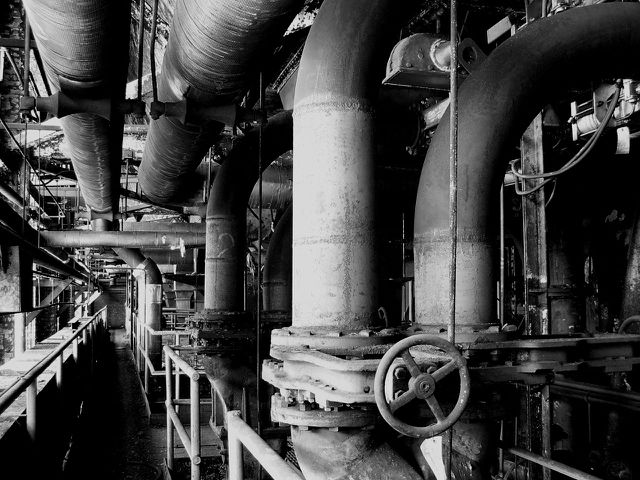Liquid Farm: Difference between revisions
m (→Examples) |
mNo edit summary |
||
| Line 5: | Line 5: | ||
[[Image:Pipes liquid farm.jpg|640px|thumb|right| Pipes everywhere on the liquid farm.]] | [[Image:Pipes liquid farm.jpg|640px|thumb|right| Pipes everywhere on the liquid farm.]] | ||
This is a concept in which bulk agricultural and other products are transported all over the farm in liquid or gaseous form via pipelines. The farm therefore | This is a concept in which bulk agricultural and other products are transported all over the farm in liquid or gaseous form via pipelines. The farm therefore resembles a chemical plant in a way. The products are moved by pumps or by a gravity differential. Pumps may be powered electrically or mechanically by wind energy. Once this pipeline infrastructure is set up, it can save labor, time, energy and costs. It provides extra security and independence. It can make use of otherwise stranded solar, wind and biomass energy. Liquids may be easier to measure and monitor than solid products. | ||
==Examples of transported liquids and gases== | ==Examples of transported liquids and gases== | ||
Revision as of 23:30, 4 March 2016
This is a concept in which bulk agricultural and other products are transported all over the farm in liquid or gaseous form via pipelines. The farm therefore resembles a chemical plant in a way. The products are moved by pumps or by a gravity differential. Pumps may be powered electrically or mechanically by wind energy. Once this pipeline infrastructure is set up, it can save labor, time, energy and costs. It provides extra security and independence. It can make use of otherwise stranded solar, wind and biomass energy. Liquids may be easier to measure and monitor than solid products.
Examples of transported liquids and gases
- freshwater, hot water, greywater
- liquid manure (from cows, pigs)
- wastewater from fish farming (to grow duckweed, azolla and cattails
- compost leachate, silage leachate, compost tea
- slurry from biogas production
- steam, superheated steam
- Compressed Air
- CO2-rich air (from compost, used for CO2 enrichment/fertilization)
- biogas, methane, pyrolysis gas (“wood gas”)
- pyrolysis oil
Needed Technologies
- Pipes: polyethylene (for most things), terracotta (local, low-tech, more failure-prone), steel pipes, copper pipes (for wood gas), cement/lime+fabric composite
- Electric motors (for pumps and fans), wind-driven pumps
- ferrocement and CEBs for bulk storage of liquids in tanks
- useful: Solar Sludge Drying system
- sensors (see below: "monitoring")
- PCR and metagenomics equipment (see below: pathogen monitoring, microbial monitoring)
Examples
- liquid manure => duckweed => cattails => for irrigation or thru (bio-)filter and then return to cycle
- aquaponics (e.g. fish culture then use wastewater for duckweed/azolla)
- compressed air => aerate compost => capure CO2-rich, hot off-gas => greenhouse
- methane => synfood
Liquid Farm Design Principles
1.) Spatial and material efficiency
- minimize distances: co-locate production and use of a resource
- minimize needed infrastructure with dual use (e.g. use same pool for tilapia and duckweed but with barrier in-between)
2.) Resource efficiency
- try to minimize resource losses (e.g. heat losses, nitrogen losses, water losses, etc.)
- channel resources to the most productive use
3.) Expandability
- keep options open for future expansion
4.) Resilience
- create buffers
- storage (e.g. cisterns, dry biomass storage, wood, water, etc.)
- backup mechanisms (e.g. use muscle-powered pump if solar fails)
5.) Interconnectedness
- the more connections between various sub-systems, the more flexibility, resilience, responsiveness to market demands
- interface with adjacent farms and the outside world
6.) Easy accessibility
- for monitoring (see below)
- for potential repairs to infrastructure
- have ability to tap into resources at every step (for sale)
7.) Flexibility
- multi-use of the infrastructure (e.g. drain azolla pool and then plant wheat or corn in the mud)
- favor products that have multiple uses (e.g. duckweed which can be fed to various animals)
- ability to quickly ramp up or down production of intermediates or finished products (e.g. have compostable but dry biomass ready for composting in anticipation of quick need for heating, CO2 and fertilizer)
8.) Data richness
- monitor all resource flows
- use predictions to channel flows in order to maximize yields and economic benefits
9.) Monitoring
- minerals, nutrients
- nitrogen (ammonia, nitrite, nitrate)
- temperatures, microclimatic conditions
- ambient gases: CO2, methane, nitrous oxide
- microbial monitoring (have capability to sterilize liquids if needed; bioconversion towards beneficial microbes)
- pathogens (see Low-Cost Diagnostics)
- heavy metals (e.g. risk of HM buildup when hyperaccumulating plants are part of a cycling system)
